Honeysuckle Alley once connected Clare Street to Market Street. It may have medieval origins, but seems to mostly be a creation of the early nineteenth century. The name refers to the sweet smelling climbing plant, which presumably grew here at some point.
The lane is not shown on the 1735 Stratchey Plan, although given that map’s unreliability this does not mean it did not exist at the time. However, most other minor thoroughfares are shown, such as Horsepond Lane or Lamb Lane.
The 1810s Town Plan seems to show that some building had taken place. It does not yet seem to be a full alleyway yet. We see a long backwards L-shaped plot divided in two. On the west side we see a building fronting Clare Street, then either a yard or another building behind that. Behind this is a very long building. On the east side are a series of small divisions, presumably small cottages, then one longer building on the other side of the property divide. At the toe of the L-shape is another building. The shape seems to suggest some sort of workshop yard. The dividing line between the two portions of the plot was probably not walled off, but show here to describe the ownership boundary.
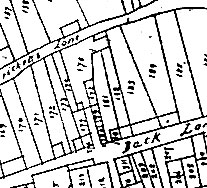
The 1835 Borough Property survey, when describing the property on the east side (181), described it being bounded by ‘Land formerly Player’s, on which several tenements are now built belonging to sundry persons, on the north with land formerly also Player’s, now Bryant’s’. This perhaps explains why the 1810s plan is divided in the middle and the 1904 reports mentions the cottages having two owners.
The 1841 census seems to be the earliest mention of the alley by name. In that census there were 26 inhabited dwellings and 3 uninhabited ones. The name possibly refers to an earlier time when this plot of land was less built up and honeysuckle was allowed to grow up the older buildings. An alternative theory, given the later squalor described below, is that the name was some sort of joke: honeysuckle being sweet smelling and a world away from the open sewer in the middle of the alley.
In 1849 the alley was struck with a Cholera epidemic: killing 7 between September 8th and October 22nd (public health chapter 4 here).
Twenty six houses (25 households and 1 empty house) are recorded in the 1851 census.
The c.1854 Town Plan shows Honeysuckle Alley now fully formed. The west side consists of nine or ten buildings, then four more buildings make up a north side making a dog leg. The east side has eleven buildings forming an L shape, then another four buildings make a further set-back east portion.
The buildings marked 228 to 231 presumably correspond to those shown on the 1810s Town Plan, 232 and 233 having been added, then 234 replacing the building at the toe. It seems as if the whole west side has been replaced.
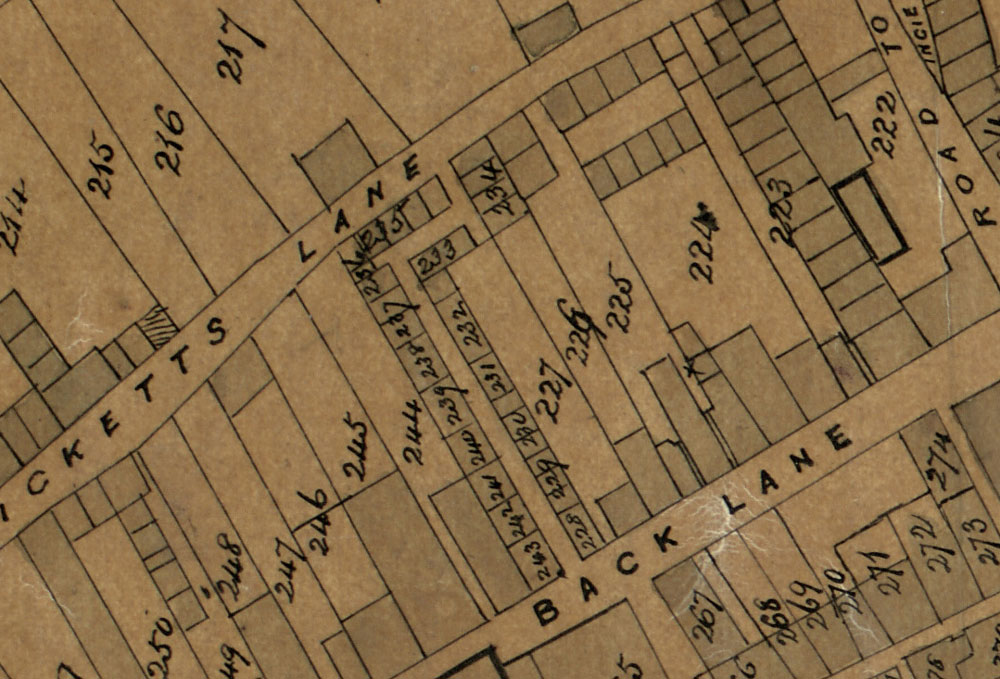
Bridgwater Mercury 2 February 1859
HONEYSUCKLE ALLEY
The chairman(Mr. R. Smith) remarked that Honeysuckle Alley, a thoroughfare leading from Back Street [Clare Street] to Prickett’s Lane [Market Street] was now a great nuisance. It contained thirty houses, and was cleaned by nobody. It was doubtful whether the houseowners there could be charged with laying down of a drain. In the road itself there was a large cesspool, and fever, small-pox, and disease of every kind prevailed in the locality. There appeared to be great difficulty, in a legal point of view, of enforcing abatement of the nuisance against householders or owners. He had taken some trouble about the matter, and called a meeting of the owners of the houses. Mr. Knowles proposed there should be a drain laid down the whole length of the alley, that it should be paved, and that the pump should be removed from the middle of the road, and the whole place should be put in order, so as to property carry off the filth. They had advertised for tenders, and the lowest amounted to £59 16s. The result of his meeting the householders was, that the owners of 23 houses were willing to pay £30 towards the outlay, and he was requested to ask the trustee to pay the remaining £30. There was not such a place left in the town. All of the houses were not occupied but calculating that each house of the 23 would be tenanted by five people, there would be 115 people to go to one privy, to one pump, and to accumulate refuse to be carried off by one little utter. This locality spread infection and disease all around, and he did not think that money could be better expended than in improving it. Mr John Trevor stated that ten years ago, the same alley was the worst nuisance in the town.
..
Mr J.R. Smith observed that there were many poor neighbourhoods which might come forward with a similar claim. The owners of the cottages in the alley derived large rents and ought to repair their own pumps, and provide decent and requisite appendages to their dwellings. That Trust ought not to be asked to provide such requisites. He was in favour of drainage, but maintained that the landlords should be compelled to provide a privy to each house.
Bridgwater Mercury 16 February 1859
MARKET HOUSE REPORT
Mr. G.B. Sully: … The drainage in Honeysuckle Alley being in a very unhealthy and dangerous state, and the inhabitants being willing to make an outlay of about £30, provided the drainage and pavement be in an effective condition.
Mr J.R. Smith: … they might, in due time, carry out the drainage… but in other parts of the town, before any expenditure had been made for a drain, the inhabitants had been summoned for permitting a nuisance. Honeysuckle Alley was the greatest nuisance in the town, but it existed because the landlords gave the tenants no water. They were asked to drain and pave it merely because there was an infant school at the back of it, and it was decided to make a fine path up to it….
G.B. Sully: …disease prevailed to an alarming extent in the neighbourhood; and if, as Mr. Smith said, there was an infant school at the back, that was an additional motive for the locality being improved with a view to benefit the health of the inhabitants. A great deal more than £30 would be expended in draining and paving the street and that work was legitimately the province of the Trust. The total estimate for providing privies, drainage, pumps and pavement was £69; out of that sum the pumps would cost £5, and the privies £8, so that the owners would contribute about £30 for the paving and draining themselves.
Mr. Holmes thought that the cost of paving might be deferred, and the draining alone done, which would itself cleanse and purify the locality.
Mr. Sully said that at present the pavement was so arranged that the slush and filth from the houses collected in the centre of the street. It was requited to be altered in order to carry impurities into the drain.
Bridgwater Mercury 2 March 1859
Mr Richard Smith recently stated that for 23 houses in Honeysuckle Alley there was only one privy, that by no law applicable to Bridgwater could the owners of the premises be made to remedy this disgraceful state of things.
Bridgwater Mercury 16 February 1860
Coroners report on the death of Harriet Sydenham, aged 46, wife of Theophilus Sydenham, a scavenger, described the home: ‘on entering the house they saw nothing but an old table, a broken stool, and two chairs, the latter they afterwards learnt had been lent by some of the neighbours… in the bedroom [upstairs]… lying upon the floor upon an old mattress, and covered by a counterpane almost black with dirt, was the deceased. No bedstead was in the room, and save a few dirty garments in a corner of the apartment, which was believed to constitute the child’s bed, not a single article was visible … the man was in the employ of the town scavengers, and was in receipt of 11s per week. His wife had been always well fed by him. She was so heaty that 7s were weekly expended in food for herself alone.’ The verdict was ultimately that she had caught a chill from collecting turnip tops and died ‘by visitation of god’.
1878
On 21 March 1878 Joseph Lewis was brought before the Borough courts for having property in Honey Suckle Alley in such as state as to be a nuisance and dangerous to health. Three or four other owners of house property in the same alley were summoned for like offences (Wells Journal 21 March 1878).
The following week Joseph was made an example of. The borough inspect of nuisances, Mr Parker, said:
‘there were twenty-three houses in Honeysuckle Alley, and only five closets covering an area of 11ft by 5ft, and the inhabitants numbered ninety-five. Two of the closets were choked at the time he saw them on the 12th March, and they were continually being choked. Five of the houses belonged to the defendant Lewis. The houses internally were much in need of whitewashing. He should not think they had been whitewashed for two or three years, and the plaster was knocked off in several places arising from dilapidations and dampness. In his opinion the condition of the premises was such as to be a nuisance and injurious to health. He had served several notices on Mr Lewis to abate similar nuisances. Sometimes there had been a little done, but nothing to meet the case. The last notice was served on 7th January and this requited the defendant to provide an additional water closet, to repair the pavement, do some whitewashing and repair the pumps. That notice had not been complied with. Mr Lewis replied that he had no ground to build upon. Parker replied that he should pill down a house or something, and added that no whitewashing had been done since the service of the last notice. There were two pumps, neither of which was in good condition. Mr F.J.C Parsons, medical officer of health, gave corroborative evidence, adding that in his opinion it was both a nuisance and injurious to health. Mr Lewis said he could have ‘all the alley’ there as witnesses if he liked, and they would state that they did not want any additional accommodation. The Mayor said the Bench had no alternative to order the abatement of the nuisance within twenty one days, and the payment of the costs by the defendant. He advised Mr Lewis to consult with the Borough Surveyor, who would tell him what was necessary to be done and how best to do it. The other owners of property in Honeysuckle Alley were summoned were Mr Vincent Case, Mr J.A. Harris, Mr John Pitman, Mr George Dunn and Mr William Blackmore. O behalf of the last named defendant, Mr Rookley said no doubt there had been a nuisance, and they were quite willing, if given sufficient time, to abate it. The Clerk said perhaps the best way would be to make an order in each case without calling the witnesses again. Mr Rookley said he understood that would involve expense for which there was no necessity. They had had one test case and that was quite sufficient. And adjournment of the other cases for a fortnight was then agreed to’ (Somerset County Gazette 23 March 1878).
Fortunately the landlords made an effort to clean up their act: ‘the work was in so advanced a stage that the Town Clerk, medical officer and himself had that morning agreed to withdraw the others summonses on payment of the costs by the defendants’ (Bridgwater Mercury 10 April 1878).
1883 Special Report
(Described in Lawrence’s History of Bridgwater, p.165) There existed 12 tiny cottages crammed along the west side, which backed onto the wall of a candle factory. Another 10 cottages on the east side, and a further five in a separate group on the north side. Some lavatory accommodation existed at that end of the alley, consisting of three cubicles without doors served by a trough lavatory and a flush at one end.
Western Gazette 14 December 1883
At the Borough Petty Sessions in 1884
Joseph Lewis, shoemaker, was summoned for using profane language in the public streets on Sunday, December 2nd, and was fined 2 shillings and costs. A.S. Cull stated the facts of the case, Joseph Lewis, shoemaker, was summoned by the Town Council, as the Urban Sanitary Authority, for permitting nuisances to exist on premises belonging to him in Honeysuckle Alley. The Town Clerk (Mr. Cook) appeared to prosecute. From the evidence of the Sanitary Inspectors it appears that the defendant is the owner of 12 houses in Honeysuckle Alley, the sanitary accommodation for which was very defective. The floors of the closets [toilets], five in number, were in a disgraceful condition, the drains were choked, and the walls and seats were covered in filth. The usual notices had been served on the defendant, who had not, however remided the state of things. The Medical Officer of Health (Mr. F.C. Parsons) recommended that the closets be removed and reconstructed. Defendant admitted that the drains at times became choked, but he had them flushed and they were now all right. The Magistrates ordered the defendant to abate the nuisance within seven days.
Taunton Courier and Western Advertiser 30 January 1884
Joseph Lewis, shoemaker of Bridgwater was summoned by the Urban Sanitary Authority , represented by Mr Cook, town clerk, for having neglected to comply with an order of the bench for the abatement of nuisances on premises belonging to him in Honeysuckle Alley. Defendant was represented by Mr. Good, from the office of Mr. Chapman. Defendant was ordered to pay the mitigated penalty of £4 10s. together the costs.
Taunton Courier and Western Advertiser 27 May 1885
Town Council – it was reported that the health committee had agreed to purchase three cottages in Honey Suckle Alley of Mr Lewis at a cost of £60, and Mr. Perrett explained that it was intended to throw open Honeysuckle Alley as a public thoroughfare and effect a considerable town improvement.
By the 1887 OS 25″ map we see where the section had been punched through to reach Market Street directly.

Bristol Times and Mirror 25 October 1892
BRIDGWATER – at the Borough Police court yesterday, Joseph Lewis, of Angel Crescent, was summoned by the Inspector of Nuisances to abate nuisances on two cottages belonging to him in Honeysuckle Alley. Mr W.T. Baker (Reed and Cook) appeared on behalf of the Town Council, and evidence was given by the inspector and assistant inspector of nuisances that the cottages were in a dilapidated condition. Defendant undertook to put the cottages in a proper state of repair on the bench adjourning the case for a week.
As well as the instance of neglect cited for Honey Suckle Alley reproduced here, Lewis also seems to have had properties at Gold’s Buildings (Western Dailey Press, 24 August 1875) and York Buildings (Central Somerset Gazette 28August 1875). The 1887 OS 25″ map shows a Lewis’ buildings in West Street and Lewis’ Court in St Mary Street. He was convicted in September 1868 for assaulting a tenant, Emma Matthews, who was in arrears, by forcing a door open into her face (Taunton Courtier 30 September 1868) and was also fined in 1879 for animal cruelty, for underfeeding some goats (Central Somerset Gazette 1 March 1879).
Taunton Courier and Western Advertiser 24 April 1901
The Health and Town Improvements Committee brought up a report recommending the purchase of the 18 houses in Honeysuckle Alley at a cost of £900, the same to be pulled down, owing to the insanitary state of the property. Several members spoke strongly against the proposal, arguing that the owners of the property should be ordered to put the same in sanitary order, and that the expenditure of such a large sum of money was not justified. The whole matter was in the end referred back to the Committee for further consideration.
Bridgwater Mercury 24 August1904
GOVERNMENT INQUIRY AT BRIDGWATER NEW CORPORATION DEPOT, MORTUARY, ETC THE DEMOLITION OF HONEYSUCKLE ALLEY
On Friday morning Mr. M.K. North M.I.C.E., Local Government Board inspector, held an inquiry in the Council Chamber, at the Town Hall, Bridgwater, relative to an application by the Corporation for sanction to borrow the sum of £2,600 for alterations and additions to the Corporation depot in Clare Street, including the provision of a mortuary and post mortem room, and of buildings for depot and fire brigade purposes.
There were present at the inquiry the Mayor (Alderman T.W. Manchip), the ex-Mayor (Councillor W. Thompson), Alderman F.C. Foster, Councillors W.H. Roberts and H.S. Pope, the Town Clerk (Mr W.T. Baker)m the medical officer of health for the borough (Dr. F.J.C. Parsons), the borough surveyor (Mr. F. Parr), the borough accountant (Mr. C. Chard), and Mr H. Dosson.
There was no opposition to the Council’s application. The Town Clerk placed before the inspector the case for the Corporation, and gave formal evidence as to the population and rateable value of the borough.
The Borough Accountant stated that the total indebtedness of the Corporation as the municipal and urban authority was £14,001, £32,826 of which was included in the waterworks undertaking, which was remunerative. The Council had an amount in consoles of £3,818, and it was proposed, with the authority of the Local Government Board, to sell such a sum as would release £2,600, to be repaid by the urban authority within a period of thirty years.
The Borough Surveyor explained the plans to the Inspector, and gave evidence to the effect that the property involved in the proposed alterations was situated in the centre of the town, and in immediate proximity to the Town Hall and administrative buildings of the Town Council. The property consisted of a row of small low class houses, which were partly situated on the east side of a thoroughfare called Honeysuckle Alley, and partly on the south side of a street called Market Street at the north end of the alley. This property was until recently owned by two people – Mr Albert Lewis and the representatives of the late Mrs. Harwood. Adjoining those houses on the east and south side, with an entrance from Clare Street, were situate the present yard, sheds, and buildings now utilised by the Town Council as their depot, and in which accommodation was found for harness room, loose box and stabling for seven horses, with fodder store over, masons’ store, engine house, water department store, shed for carts and stored, and shed for the housing of the fire brigade and fire escape. Those buildings for Corporation and fire brigade purposes were now quite inadequate and overcrowded. Many of the appliances had to be stored elsewhere when not in daily use. With regard to the dwelling houses, the attention of the Health Committee was drawn to their condition in October 1900, through a complain by one of the medical practitioners of the town, and on being inspected by a sub-committee and the health officer of the Corporation it was deemed advisable to recommend the Council to acquire the property, some of the houses bring considered to be in a most insanitary condition. The proposals of the sub committee were not confirmed by Council, because it was thought at the time in question it was advisable to defer taking immediate action. Matters remained in that state until the death of the owner of some of the property in July 1903, and on the property being put up for auction by her representatives in August 1903, it was acquired by the Town Council for the sum of £495 and fees 14 guineas. After that ssale negotiations were carried on with Mr. Lewis for the purchase of his portion of the property, with the result that it was also acquired for the sum of £300. After the purchase of the two properties the sub-committee, whom the Council had appointed to carry out the purchase negotiations, were further instructed to prepare a scheme for dealing with the area acquired by enlarging the present depot and providing the much wanted and necessary accommodation, with the result that out of several plans and estimates prepared the one now before the Local Government Board was approved by the Health Committee, and confirmed by the Town Council. The scheme included the removal of the whole of the dwelling house property purchased by the Corporation, and the engine house in the present depot. The stable building in its entirety and the fire escape shed would be retained, but the former would be altered to provide further accommodation. The new buildings comprised the following additional accommodation commencing where Clare Street and Honeysuckle Alley met and then proceeding northwards:- (1) fire brigade and large appliances’ room and cleaning or working room, fitted with pipe trough, hot water boiler, etc, for cleaning hose, and brigade room for men on duty, and attached to that a small yard with necessary sanitary fittings; (2) Highways Committee – a spacious two-storied building for tool and stores of all descriptions together with foreman’s office, the first floor to be used for the storage of cement. Adjoining was an open shed capable of holding under cover all the various water carts, horse brush scraper, hand carts, and other rolling stock belonging to the Town Council. At the north end of the shed were sanitary conveniences for the men, and also a two storied building proposed to be utilised as a masons’ and general store. (3) Watch Committee – at the north wast corner of the site it was proposed to erect a small building entirely disconnected and separate from the general yard, to be used as a mortuary and post mortem room. (4) Highways department. At the northern end of the site against Market Street was a shed for the steam road roller. (5) Water department. Alongside the last shed was a store for the keeping of water pipes and fittings of all descriptions used in the Corporation water undertaking, and adjoining that was a plumber’s shop. (6) Highways department – As to the existing buildings, which at present was utilised as a mason’s and general store, other places being provided, the Council were of opinion that that building should be entirely devoted to stable purposes. With regard to the mortuary and post mortem room, the Surveyor pointed out that in planning that accommodation all possible precautions had been taken with regard to separating the living from the dead, and that all materials in or near the death chambers were as far as possible non absorbent. The floor was cement concrete, and the walls throughout of white glazed bricks.
In reply to the Inspector the Surveyor explained that the houses referred to were purchased to get rid of an insanitary area as well as to give the Corporation better facilities for dealing with the depot.
The Mayor said the latter was the main object for which the property was purchased.
The Inspector: It is rather an important point.
Councillor Roberts: The primary object was to form the depot.
The Borough Surveyor: The houses were in wretched order, and it is proposed to demolish them all.
The Inspector: What are they, 300 years old or older, or does anybody not know?
The Borough Surveyor: Very much older than that I should say.
The Inspector: All these dwellings have been closed and the occupants have left?
The Borough Surveyor: Yes, they soon cleared out when we asked for the rent. (Laughter).
The Inspector: As to the housing of these people you have disturbed, can you give me any information where they have gone or what became of them? They were of the working class, I suppose?
The Borough Surveyor: Yes, They were almost the lowest class we have in our town, and they have gone into cheaper houses in the courts.
The Mayor: Better built houses.
The Inspector: Have they gone outside the borough?
The Borough Surveyor: No. There has been a large amount of building going on, and many of the people living in courts have gone to better houses, and so let the houses in the courts.
The Inspector: The people you have displaced, had they much difficulty in finding accommodation?
The Borough Surveyor: I should say not.
The Inspector: Are the courts pretty near the same site?
The Borough Surveyor: They are all around the borough, but principally on this side of the river.
The Inspector: All within half a mile?
The Borough Surveyor: Yes.
The Inspector: And within reasonable distance of where the people are employed?
The Borough Surveyor: Yes.
Dr. F.J.C. Parsons, as medical officer of health, gave information respecting the mortuary, after which the Inspector said he had got all the information he required, but he asked if anybody wanted to address him or to ask any questions.
There was no response, but the Town Clerk pointed out to the Inspector that the Mayor could give evidence as to the necessity of the Council’s proposals.
The Inspector: I think the evidence I have is ample, I have viewed the site, and I declare the inquiry closed.
Western Daily Press 17 February 1905
The Council accepted the tender of Mr. S. Palmer, of Camden Road, amounting to £1,540, for the necessary works in connection with the removal and pulling down of existing property [on the east side of] Honeysuckle Alley and the scavengers’ yard, and the erection of additions to the Fire Station, Mortuary, cart shed, engine-house, and various stores.
It is at this time that the name Honeysuckle Alley seems to fall out of use, in favour of Clare Terrace. The last mention of Honeysuckle Alley seems to be April 1906 (Wells Journal 12 April 1906). The earliest instance of Clare Terrace being used as the name found so far is July 1909 (Western Daily Press 28 July 1909).
In the 1911 census there were at least nine properties which made up Clare Terrace, presumably the remainder of Honeysuckle Alley on the west side (with thanks to Mike Searle).
Western Daily Press 05 September 1930
At a special meeting of the Bridgwater Town Council yesterday it was resolved to make demolition orders in respect of premises Nos 1 to 10 Clare Terrace.
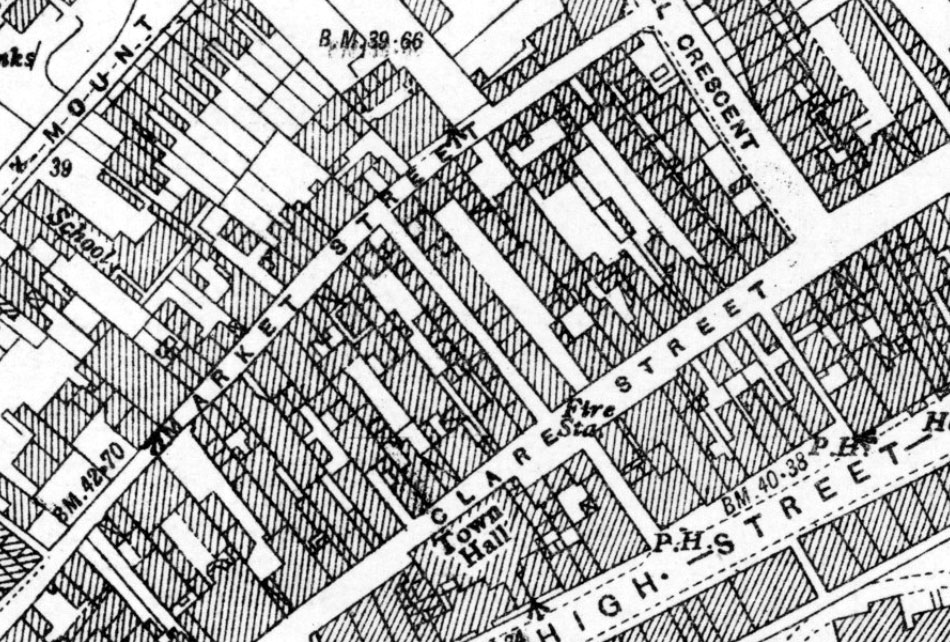
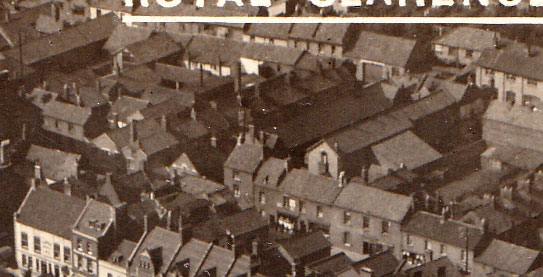
No houses appear for Clare Terrace or Honeysuckle Alley in the 1937 Whitby Light and Lane Directory. It seems although the street still existed, no one now lived there.
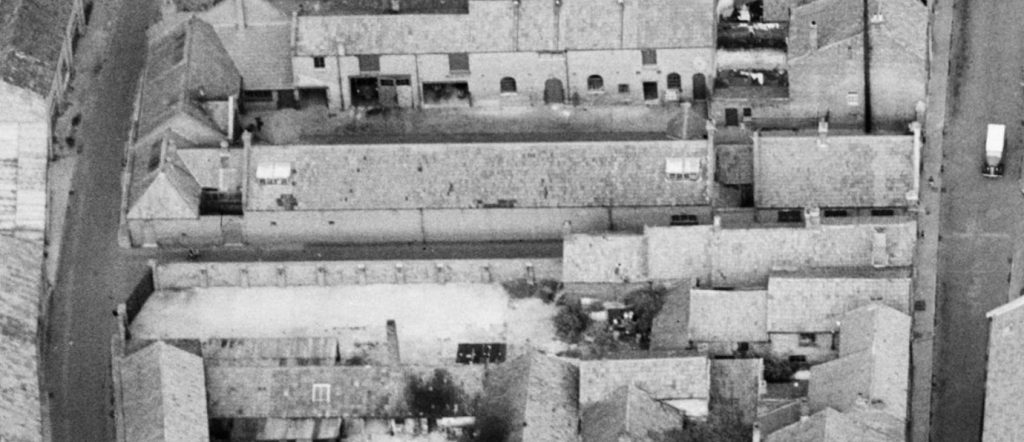

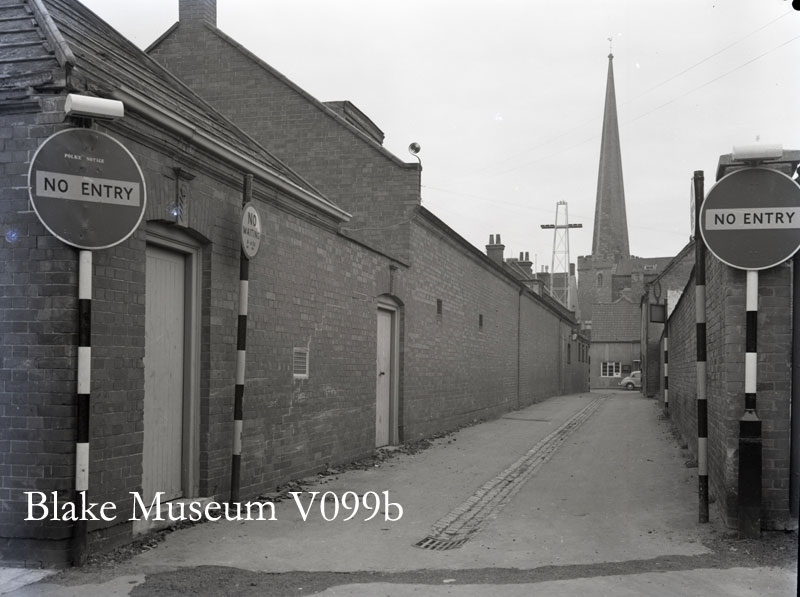
From 1954 the whole area between Clare Terrace and Angel Crescent was demolished in phases and converted into a car park.
In the 1960s Kelly’s Directory, Clare Terrace is mentioned in Clare and Market Streets, but there is no separate heading, suggesting again that although the street existed, no dwellings were there.
In 1962 Clare Terrace was made a one-way street with no waiting allowed. Taunton Courier and Western Advertiser (7 April 1962).
Bristol Evening Post 16 June 1965
REBUILD AREA, INSPECTOR SAYS
The whole area around Clare Terrace, Bridgwater, is inappropriately used, in a dilapidated condition, and calls out to be rebuilt. This is the conclusion reached by Mr. J.B.S. Dahl, an Inspector of the Ministry of Housing and Local Government, who held an inquiry into Bridgwater Town Council’s refusal to permit Mr. A.J. Ferguson to convert premises in Clare Terrace from a store into a shop. The Inspector noted the council expected to have acquired the premises within a year, proposing to use it for parking. In the circumstances, he did not think permission for the change of use to a shop was justified even for a temporary period.
Clare Terrace does still appear on the Town Plan for 1974.
Bristol Evening Post 22 February 1982
Shops Traffic Ban Planned. The multi-million pound Angel Place shopping development in Bridgwater, which is due to start in July, could mean a ban on traffic. … it is proposed to stop up part of Angel Crescent, Market Street and Clare Street, and the whole of Clare Terrace and Old Oak Lane. A new service road would be provided at the rear of Angel Place, connecting Mount Street with Clare Street and York Buildings and another new highway would serve the shopping development, provide rear access to properties in Mount Street.
MKP May 2023
